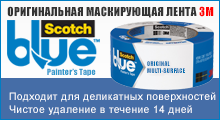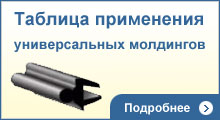| АВТОСТЕКЛА: продажа автостекол, доставка и установка автостекол в Москве |
в мире автостекол
| Email для связи: |
НОВЫЕ ПОСТУПЛЕНИЯ Полезный инструмент для очистки U-образного паза 
720 руб.
СПЕЦ. ПРЕДЛОЖЕНИЕ Скотч прозрачный на акриловой основе (41х24х1.5мм) для линз датчиков дождя/света/solar RLSS от компании PRP Precision. 12 моделей 
90 руб.
А ЗНАЕТЕ ЛИ ВЫ, ЧТО... О принципе 75%: в некоторых европейских странах, в частности в Германии, принято считать, что если ремонт детали стоит не дороже 75% ее стоимости, то деталь следует ремонтировать, если больше, то это уже не целесообразно и не рентабельно.
|
Toyota Sequota 20102010 Toyota Sequota.
Vehicle type: Four-door utility vehicle
NAGS numbers*: Windshield part numbers FW2721 third visor, solar; FW2722 third visor, solar, heated wiper park; FW2723 infrared interlayer, solar, third visor; FW2724 infrared interlayer, solar, third visor, heated wiper park; FW3217 third visor, solar; and FW3218 third visor, solar, heated wiper park. Quarter glass part numbers FQ23327/28 – R/L, solar, antenna; and FQ23329/30 – R/L, solar, antenna, sunshade hooks Watch for: The leading edge cowl retainers break easily; take care to avoid damaging them. A. Windshield
Preparation 1. Cover the front seats, floorboards, dash and steering wheel with a clean drop cloth or disposable plastic covers. Note: Always wear eye and hand protection when working with glass. Make sure you have the right glass and moldings and that the urethane systems you are about to use are current. Windshield part numbers are FW2721, FW2722, FW2723, FW2724, FW3217 and FW3218. 2. Drape the fender with a fender cover and tape up any vulnerable areas on the vehicle to protect against possible damage. Tape up the defroster vents to prevent debris from falling into the openings. 3. Remove the rearview mirror by loosening the set screw in the mirror base and sliding the mirror off the pad. 4. Remove the windshield-wiper nuts using a 14-millimeter wrench or socket.
5. Remove the two faux Phillips screw retainers from the corners. 6. On the leading edge of the cowl, there are five clips that snap into holes on the fire wall. They break easily; take to avoid damaging them.
7. Remove the cowl fender trim by sliding them out from under the top edge of the fender and off the corner of the cowl panel.
8. Under the cowl panel on the driver side is the wiring harness for the heated wiper park area of the windshield. Disconnect the harness and tape it to the windshield during the cutout process.
9. There is no top molding. It is a PAAS-type underside molding. 10. Peel out the side moldings. Note: Before beginning windshield removal, verify the new windshield is the correct one and the urethanes and primers are current. Never use outdated products as this could jeopardize the structural integrity of the vehicle and the safety of its passengers.
Removal
11. Make sure cutting blades are sufficiently sharp. 12. Before cutting out the windshield, remove contaminants from the glass and pinchweld to prevent contact with the urethane. 13. The glass cutout is easy on this vehicle, and there is plenty of room to use a cold knife and power tool. Use a cold knife to cut out the windshield along the top. Use the tool of your choice to remove the glass from the adhesive bead on the sides and bottom. If you use a power tool, lubricate the cutting area with water. There are no gravity stops on this vehicle; use a temporary stop or tape to prevent the glass from sliding off the fresh urethane. 14. Take the windshield out of the opening using a set of vacuum cups. Make sure the vacuum cups do not overlap a crack in the glass. Lift the glass and place it on a windshield stand or suitable workstation. Installation
15. After cutting the windshield out, remove contaminants such as dirt, moisture and debris from the pinchweld. Clean the dashboard. 16. Dry fit the new glass to the opening. Mark your glass using a grease pencil or retention molding tape. 17. Place your vacuum cups on the new windshield in the appropriate location. 18. Set the windshield onto the old urethane. 19. With the windshield resting in the opening, make sure it is in the right spot. 20. Adjust both sides to the correct setting, marking the passenger side, then the driver side. Lift the glass and place it on a windshield stand or suitable workstation. 21. Follow the urethane manufacturer's recommendations for installation. 22. Clean the inside of the windshield using a urethane manufacturer-recommended product. Do not touch the bonding area of the windshield after cleaning, prepping or priming it. 23. Wear powder-free Nitrile gloves to protect against harsh chemicals. 24. Apply the glass prep and primer following the urethane manufacturer's recommendations. 25. Using the tool of your choice, remove the original urethane bead, leaving 1 mm-2 mm of existing urethane on the pinchweld. Make sure there are no contaminants and do not touch the pinchweld after you have prepped the area. 26. Apply the pinchweld primer only to the areas where needed, and follow the urethane manufacturer's recommendations. Allow preps and primers to dry as recommended by the urethane manufacturer. 27. Apply a triangular bead of urethane to the same path as the freshly cut urethane on the pinchweld. Before cutting your V-notch, cut the tip off of your nozzle with a nozzle-cutter. With the cut nozzle, measure to the top of the roofline, and at 1/16-inch higher than the roofline, make a mark on the nozzle with a pen or marker. Notch the nozzle up to the marked line; this will give you the appropriate triangular bead. 28. Lift the windshield from the windshield stand or workstation using vacuum cups. Set the windshield on the urethane at the mark you made during your dry fit. Lower the driver's side of the windshield onto the urethane and line it up with the dry-fit mark; it is now in place. 29. The windshield is now ready to be decked. Press firmly to ensure a good seal. 30. Re-install the side moldings by inserting them between the glass edge and the wall of the A-pillar pinchweld. 31. Check for leaks. Use a leak detector to go over the perimeter of the windshield. If you find a leak, apply more pressure or add more urethane to the spot and ensure that the glass makes contact with the wet urethane. 32. Allow the urethane to cure according to the urethane manufacturer's recommended cure time before returning the vehicle to the customer. Warning: Disregarding the safe drive-away time that your urethane manufacturer recommends could jeopardize the structural integrity of the vehicle and the safety of its passengers. 33. You have completed the removal and replacement of the windshield. B. Quarter glass
Removal 1. Make sure that you have the right glass. Quarter glass part numbers are FQ23327/28 – R/L and FQ23329/30 – R/L. 2. If the goal is to salvage and reuse the quarter glass, then the interior moldings must be removed to facilitate disconnection of the antenna wiring. 3. Begin by removing the screw covers marked "SRS". Remove the two 10-mm screws behind the covers.
4. Remove the seat control panel near the rear of the vehicle. Behind the screw cover is a 10-mm screw. Remove the control panel and disconnect the wiring.
5. The package tray has a special retainer that must be removed. The secret is to pull and not pry out the retainer.
6. Remove the C-pillar molding by pulling outward with your hands. There are five retainers behind the trim panel. Follow the same steps for removal of the D-pillar molding.
7. Remove the header molding by pulling away from the top and releasing the four retainers behind it.
8. Remove the quarter panel by releasing the four retainers.
9. Disconnect the antenna wiring harness and tape it to the vehicle so that it is out of the way.
10. Cut out the quarter glass using the tool of your choice. If using a power tool, lubricate the cutting area with water. The glass has an exposed edge that is close to the vehicle body. There are no moldings. There are two locator pins in the top and bottom corners of the glass.
Installation
11. After cutting the quarter glass out, remove contaminants such as dirt, moisture and debris from the pinchweld. 12. Dry fit the new glass to the opening. Mark your glass using a grease pencil or retention molding tape. 13. Place your vacuum cups on the new glass in the appropriate location. 14. Set the quarter glass onto the old urethane. 15. With the glass resting in the opening, make sure it is in the right spot. 16. Adjust both sides to the correct setting. Lift the glass and place it on a windshield stand or suitable workstation. 17. Follow the urethane manufacturer's recommendations for installation. 18. Clean the inside of the quarter glass using a urethane manufacturer-recommended product. Do not touch the bonding area of the glass after cleaning, prepping or priming it. 19. Wear powder-free Nitrile gloves to protect against harsh chemicals. 20. Apply the glass prep and primer following the urethane manufacturer's recommendations. 21. Using the tool of your choice, remove the original urethane bead, leaving 1 mm-2 mm of existing urethane on the pinchweld. Make sure there are no contaminants and do not touch the pinchweld after you have prepped the area. 22. Apply the pinchweld primer only to the areas where needed, and follow the urethane manufacturer's recommendations. Allow preps and primers to dry as recommended by the urethane manufacturer. 23. Apply a triangular bead of urethane to the same path as the freshly cut urethane on the pinchweld. Before cutting your V-notch, cut the tip off of your nozzle with a nozzle-cutter. With the cut nozzle, measure to the top of the roofline, and at 1/16-inch higher than the roofline, make a mark on the nozzle with a pen or marker. Notch the nozzle up to the marked line; this will give you the appropriate triangular bead. 24. Lift the quarter glass from the windshield stand or workstation using vacuum cups. Set the glass on the urethane at the mark you made during your dry fit. Line it up with the dry-fit mark; it is now in place. 25. The quarter glass is now ready to be decked. Press firmly to ensure a good seal. 26. Re-install the removed parts in reverse order. 27. Check for leaks. Use a leak detector to go over the perimeter of the glass. If you find a leak, apply more pressure or add more urethane to the spot and ensure that the glass makes contact with the wet urethane. 28. Allow the urethane to cure according to the urethane manufacturer's recommended cure time before returning the vehicle to the customer. Warning: Disregarding the safe drive-away time that your urethane manufacturer recommends could jeopardize the structural integrity of the vehicle and the safety of its passengers. 29. You have completed the removal and replacement of the quarter glass. Article by Bob Beranek |







